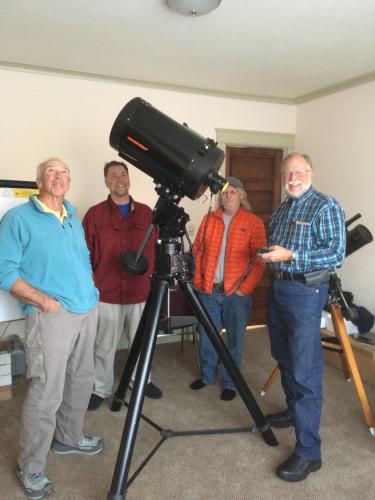A small but spirited group of novice learners joined other enthusiastic amateur astronomers on December 3rd at the Oliver House for the first four-hour Norwood Dark Skies Telescope Workshop. Emphasis is rightfully placed on this first four hour workshop because of how fast the time passed while we merely scratched the surface of what there is to be learned about sky gazing and the cosmos.
Just learning about the various types of telescopic equipment is a good starting place, especially for those with very little experience who want a closer view of our beautiful dark night skies. Even a standard pair of binoculars can be used to look at the night sky, and of course, some binoculars are specially equipped for nighttime viewing. Being readily usable and portable are certainly advantages to this bi-optic approach; but maintaining a steady focus presents a challenge.
Consequently the use of a tripod mounted telescope will provide a more stable platform for focusing in on celestial objects. Embarking on such a sky quest brings many questions quickly to mind. The first question is likely to be, "which telescope would be the best for me and/or what telescope would be best to get started with?" We were promptly informed that the best telescope for anyone is the one that gets used the most. While that did indeed make total sense, it was ever more helpful to be introduced to the three basic design choices.
The first type of telescope, called a refracting telescope, concerns the bending of light and is derived from the word "refract" meaning "to bend." This type of telescope was first employed soon after the development of lenses and was used by the likes of Galileo. But glass lenses can only be made so big and no bigger. Then along comes Isaac Newton who invented the reflector, the second type of telescope. This design combines a primary parabolic mirror with a smaller secondary mirror and focus tube, all of which allow for larger apertures (light gathering opening) so more light can enter the telescope, thus increasing visibility of faint objects. The third type, called a compound telescope, combines reflection and refraction of light. With the addition of a front end corrector plate surrounding a center area reversing mirror, this design allows for a more compact design but with equivalent power.
Naturally this limited information about telescopes, so briefly explained, will only serve to raise many more questions for any beginner; such as: Should I buy binoculars before I buy a telescope? Beyond making things appear bigger what are telescopes actually doing? Why are objects seen through a telescope upside-down? Can a telescope be used to view earthly objects? Are telescopes all complete with no need for additional items? Apart from the quality of optics what is the most important thing in a telescope? Is a "go-to" scope better than one without "go-to"? Will some telescopes need electricity to operate? Is there a way to "test-drive" a telescope? The answer to this last question would be a definite “Yes!" if you attend our next telescope workshop.
After achieving a basic understanding of and/or knowledge about telescopes, perhaps the most important question of all will be: How does one orient the telescope toward what it is that they wish to see? We were getting a start on that as our time in this first session was running short; nonetheless, learning to locate North with the star Polaris showed how to align the tripod. Of course there is so much more to learn with declination, ascension, latitude and longitude, as well as, arcs, degrees, minutes, seconds, and the celestial axis, poles, and equator... Future sessions will certainly dive deeper into all this so we hope that those of you that are interested will join us.
Fortunately, we have an experienced instructor in Creighton “Woody” Wood. He along with Robert Grossman is the driving force behind Norwood obtaining an international Dark Skies Designation. Our area has some of the best dark skies meter measurements in the nation/world. You may have already read other Post articles and seen the photograph of Andromeda in an earlier edition. This is the nearest galaxy to our own and the telephoto print was taken right here from our dark sky plateau.

From left to right John Mansfield shows Andrew Kaufmann, Rick Hollinbeck, and Woody Wood how to view without a telescope. (Picture by Bob Grossman)
